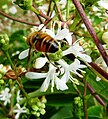Heptacodium miconioides
| Heptacodium miconioides | ||||||||||||
|---|---|---|---|---|---|---|---|---|---|---|---|---|
|
Habitus |
||||||||||||
| Systematics | ||||||||||||
|
||||||||||||
| Scientific name of the genus | ||||||||||||
| Heptacodium | ||||||||||||
| Rehder | ||||||||||||
| Scientific name of the species | ||||||||||||
| Heptacodium miconioides | ||||||||||||
| Rehder |
Heptacodium miconioides , also known as the seven bells or seven sons shrub , is the only species in the genus Heptacodium from the honeysuckle family (Caprifoliaceae). The species grows shrub-like and occurs naturally only in a few Chinese provinces. It is sometimesusedas an ornamental plant because of its flowers.
description
Heptacodium miconioides is a deciduous, 3 to 5 meter, rarely 7 meter high shrub with peeling bark and red-brown, sparsely hairy young twigs and buds.
The leaves are opposite and have a stalk about 10 millimeters long. The leaf blade is simple, 8 to 15 centimeters long and 5 to 9 centimeters wide, leathery, oblong egg-shaped, tapered and pointed and with a heart-shaped base and entire or wide and shallowly curved leaf margin. The edges are usually bent upwards, making the blade boat-shaped. The upper side of the leaf is matt dark green, the underside lighter and somewhat hairy on the leaf veins. Next to the midrib there is a weaker, parallel lateral nerve. The autumn color of the foliage is purple-brown.
The flowers are usually arranged in groups of six in panicle-like, 5 to 15 centimeters long and 5 to 9 centimeters wide inflorescences, which are formed on this year's long shoots. The partial inflorescences are long-stalked and multiple three-part. The individual flowers are white, hermaphrodite, strongly scented and five-fold. The calyx is small, purple and persistent. Until the fruit is ripe, it increases from 2 to 2.5 millimeters to 7 to 10 millimeters. The five petals are narrowly elongated and have white stamens.
Solitary, 1 centimeter long, oblong, cylindrical nuts are formed as fruits. At the beginning, these are surrounded by pink to purple sepals. The seeds reach a length of 5 to 6 millimeters.
The species blooms from July to September, the fruits ripen from September to November.
The number of chromosomes is 2n = 28.
photos
Distribution and ecology
The natural range of Heptacodium miconioides is in the three Chinese provinces of Anhui , Hubei and Zhejiang . There the species grows in steppes and dry forests at an altitude of 600 to 1000 meters on fresh, weakly acidic to weakly alkaline, sandy-loamy to loamy, moderately nutrient-rich soils in sunny to light-shaded locations. The species loves warmth and is usually frost hardy.
In the Red List of the IUCN is Heptacodium miconioides out as endangered ( "vulnerable"). It is pointed out, however, that a new review of the hazard is necessary. The stocks are mainly decreasing due to the indiscriminate logging of forests.
Systematics and research history
HEPTACODIUM MICONIOIDES is the only type which therefore monotypic genus Heptacodium in the family of Honeysuckle (Caprifoliaceae), subfamily Capri Folio ideae. Alfred Rehder first described the species and genus in 1916. The origin of the generic name he has chosen is unclear. It could be derived from the Greek “hepta” for “seven” and “kodia” for “poppy head” and refer to the ovary formed from seven carpels. A synonym of the species is Heptacodium jasminoides Airy Shaw .
use
Heptacodium miconioides is sometimes used as an ornamental plant because of its decorative flowers .
proof
literature
- Andreas Roloff , Andreas Bärtels: Flora of the woods. Purpose, properties and use. With a winter key from Bernd Schulz. 3rd, corrected edition. Eugen Ulmer, Stuttgart (Hohenheim) 2008, ISBN 978-3-8001-5614-6 , p. 331.
- Wu Zheng-yi, Peter H. Raven, Deyuan Hong (Eds.): Flora of China . Volume 19: Cucurbitaceae through Valerianaceae, with Annonaceae and Berberidaceae . Science Press / Missouri Botanical Garden Press, Beijing / St. Louis 2011, ISBN 978-1-935641-04-9 , pp. 618 (English).
- Helmut Genaust: Etymological dictionary of botanical plant names. 3rd, completely revised and expanded edition. Nikol, Hamburg 2005, ISBN 3-937872-16-7 (reprint from 1996).
Individual evidence
- ↑ a b c Roloff et al .: Flora of the Woods , p. 331
- ↑ a b c Liguo Fu, Nan Li, Thomas S. Elias, Robert R. Mill: Heptacodium miconioides . In: Wu Zheng-yi, Peter H. Raven, Deyuan Hong (Eds.): Flora of China . Volume 19: Cucurbitaceae through Valerianaceae, with Annonaceae and Berberidaceae . Science Press / Missouri Botanical Garden Press, Beijing / St. Louis 2011, ISBN 978-1-935641-04-9 , pp. 618 (English).
- ^ Heptacodium miconioides at Tropicos.org. In: IPCN Chromosome Reports . Missouri Botanical Garden, St. Louis
- ↑ Heptacodium miconioides in the endangered Red List species the IUCN 2011. Posted by: World Conservation Monitoring Center, 1998. Retrieved on 5 February 2012th
- ^ Heptacodium miconioides. In: Germplasm Resources Information Network (GRIN). United States Department of Agriculture, accessed February 5, 2012 .
- ↑ Exactly: Etymological Dictionary of Botanical Plant Names , p. 285
- ^ Heptacodium jasminoides. In: The Plant List. Retrieved February 5, 2012 .


